Effect of Pretreatment on a Copper Concentrate with High Arsenic Content
Abstract
:1. Introduction
2. Materials and Methods
2.1. Copper Concentrate Sample
2.2. Experimental Design
2.3. Curing Experiments
3. Results and Discussion
3.1. Copper Concentrate Characterization
3.2. Curing Test
3.3. Response Surface Methodology
3.3.1. Predictor Model
| b0 | 1.9176 |
| b1 | −1.0282 |
| b2 | 0.0892 |
| b3 | 0.0465 |
| b4 | 0.0949 |
| b11 | 0.0110 |
| b22 | −0.0002 |
| b33 | 0.0002 |
| b44 | 0.0004 |
| b12 | 0.0096 |
| b13 | 0.0043 |
| b14 | −0.0051 |
| b23 | −0.0005 |
| b24 | −0.0050 |
| b34 | 0.0001 |
- Y: Response variable.
- X1, X2, X3, X4: Factors (curing time, H2SO4 concentration, NaCl concentration, and temperature, respectively).
- b1, b2, b3, b4: Linear coefficients for each factor.
- c11, c22, c33, c44: Quadratic coefficients for each factor squared.
- c12, c13, c14, c23, c24, c34: Interaction coefficients between pairs of factors.
- E: Error.
3.3.2. Response Surfaces
4. Conclusions
Author Contributions
Funding
Institutional Review Board Statement
Informed Consent Statement
Data Availability Statement
Conflicts of Interest
References
- Cochilco RPI. Proyección de la Producción de Cobre en Chile 2023–2034. 2024. Available online: https://www.cochilco.cl/Mercado%20de%20Metales/Proyecci%C3%B3n%20de%20la%20producci%C3%B3n%20esperada%20de%20cobre%202023-2034_Vfinal2.pdf (accessed on 27 December 2023).
- Cochilco RPI. Proyección de la Producción de Cobre en Chile 2022–2033. 2022. Available online: https://www.cochilco.cl/Mercado%20de%20Metales/Proyecci%C3%B3n%20de%20la%20producci%C3%B3n%20esperada%20de%20cobre%202022-2033.pdf (accessed on 2 October 2023).
- Mandal, B.K.; Suzuki, K.T. Arsenic Round the World: A Review. Talanta 2002, 58, 201–235. [Google Scholar] [CrossRef] [PubMed]
- Cochlco RPI. Exportación de Concentrados de Cobre: Caracterización de Condiciones Comerciales. 2021. Available online: https://www.cochilco.cl/Mercado%20de%20Metales/2021%2006%2002%20Exportaci%C3%B3n%20de%20concentrados%20de%20cobre%20-%20Caracterizaci%C3%B3n%20de%20condiciones%20comerciales.pdf (accessed on 22 March 2023).
- Olvera, O.G.; Dixon, D.G.; Asselin, E. Electrochemical study of the dissolution of enargite (Cu3AsS4) in contact with activated carbon. Electrochim. Acta 2013, 107, 525–536. [Google Scholar] [CrossRef]
- Cerda, C.P.; Taboada, E.; Jamett, N.E.; Ghorbani, Y. Effect of Pretreatment on Leaching Primary Copper Sulfide in Acid-Chloride Media. Minerals 2018, 8, 1. [Google Scholar] [CrossRef]
- Hernández, P.C.; Dupont, J.; Herreros, O.; Jimenez, Y.P.; Torres, C.M. Accelerating copper leaching from sulfide ores in acid-nitrate-chloride media using agglomeration and curing as pretreatment. Minerals 2019, 9, 250. [Google Scholar] [CrossRef]
- Taboada, M.E.; Hernández, P.C.; Padilla, A.P.; Jamett, N.E.; Graber, T.A. Effects of Fe+2 and Fe+3 in Pretreatment and Leaching on a Mixed Copper Ore in Chloride Media. Metals 2021, 11, 866. [Google Scholar] [CrossRef]
- Liu, Q.; Liao, Y.; Wu, Y.; Xi, J.; Ji, G. Research progress on enhancing leaching efficiency of chalcopyrite. Huagong Jinzhan/Chem. Ind. Eng. Prog. 2022, 41, 6099–6110. [Google Scholar] [CrossRef]
- Vargas, T.; Estay, H.; Arancibia, E.; Díaz-Quezada, S. In situ recovery of copper sulfide ores: Alternative process schemes for bioleaching application. Hydrometallurgy 2020, 196, 105442. [Google Scholar] [CrossRef]
- Aracena, A.; Rodríguez, E.; Jerez, O. Enargite leaching under ammoniacal media with sodium persulfate and consecutive precipitation of As/Cu with Na2S/NaHS. Hydrometallurgy 2020, 192, 105290. [Google Scholar] [CrossRef]
- Phuong Thao, N.T.; Tsuji, S.; Jeon, S.; Park, I.; Tabelin, C.B.; Ito, M.; Hiroyoshi, N. Redox potential-dependent chalcopyrite leaching in acidic ferric chloride solutions: Leaching experiments. Hydrometallurgy 2020, 194, 105299. [Google Scholar] [CrossRef]
- Jahromi, F.G.; Cowan, D.H.; Ghahreman, A. Lanxess Lewatit® AF 5 and activated carbon catalysis of enargite leaching in chloride media; a parameters study. Hydrometallurgy 2017, 174, 184–194. [Google Scholar] [CrossRef]
- Yang, W.; Qian, L.; Jin, B.; Feng, Q.; Li, L.; He, K.; Yang, J. Leaching behaviors of copper and arsenic from high-arsenic copper sulfide concentrates by oxygen-rich sulfuric acid leaching at atmospheric pressure. J. Environ. Chem. Eng. 2022, 10, 107358. [Google Scholar] [CrossRef]
- Ruiz, M.C.; Vera, M.V.; Padilla, R. Mechanism of enargite pressure leaching in the presence of pyrite. Hydrometallurgy 2011, 105, 290–295. [Google Scholar] [CrossRef]
- Quezada, V.; Roca, A.; Benavente, O.; Cruells, M. Effect of curing time on copper leaching from chalcopyrite. In Proceedings of the COM Hosting Copp 2019, Vancouver, BC, Canada, 18–21 August 2019; p. 11. [Google Scholar]
- Quezada, V.; Roca, A.; Benavente, O.; Cruells, M.; Melo, E. The effects of sulphuric acid and sodium chloride agglomeration and curing on chalcopyrite leaching. Metals 2021, 11, 873. [Google Scholar] [CrossRef]
- Neira, A.; Pizarro, D.; Quezada, V.; Velásquez-Yévenes, L. Pretreatment of copper sulphide ores prior to heap leaching: A review. Metals 2021, 11, 1067. [Google Scholar] [CrossRef]
- Gutierrez, H.; de la Vara, R. Análisis y Diseño de Experimentos; McGraw-Hill Interamericana: New York, NY, USA, 2008; Volume 2, ISBN 978-970-10-6526-6. [Google Scholar]
- Herreros, O.; Viñals, J. Leaching of sulfide copper ore in a NaCl-H2SO4-O2 media with acid pre-treatment. Hydrometallurgy 2007, 89, 260–268. [Google Scholar] [CrossRef]
- Carneiro, M.F.C.; Leão, V.A. The Role of Sodium Chloride on Surface Properties of Chalcopyrite Leached with Ferric Sulphate. Hydrometallurgy 2007, 87, 73–82. [Google Scholar] [CrossRef]
- Yévenes, L.V.; Miki, H.; Nicol, M. The dissolution of chalcopyrite in chloride solutions: Part 2: Effect of various parameters on the rate. Hydrometallurgy 2010, 103, 80–85. [Google Scholar] [CrossRef]
- Quezada, V.; Roca, A.; Benavente, O.; Keith, B.; Melo, E. Effect of pretreatment prior to leaching on a chalcopyrite mineral in acid media using NaCl and KNO3. J. Mater. Res. Technol. 2020, 9, 10316–10324. [Google Scholar] [CrossRef]
- Senanayake, G. Review of theory and practice of measuring proton activity and pH in concentrated chloride solutions and application to oxide leaching. Miner. Eng. 2007, 20, 634–645. [Google Scholar] [CrossRef]
- Salinas-Farran, L.; Neethling, S.J. Modelling the curing of agglomerated ores with comparison to micro-CT. Miner. Eng. 2023, 202, 108240. [Google Scholar] [CrossRef]

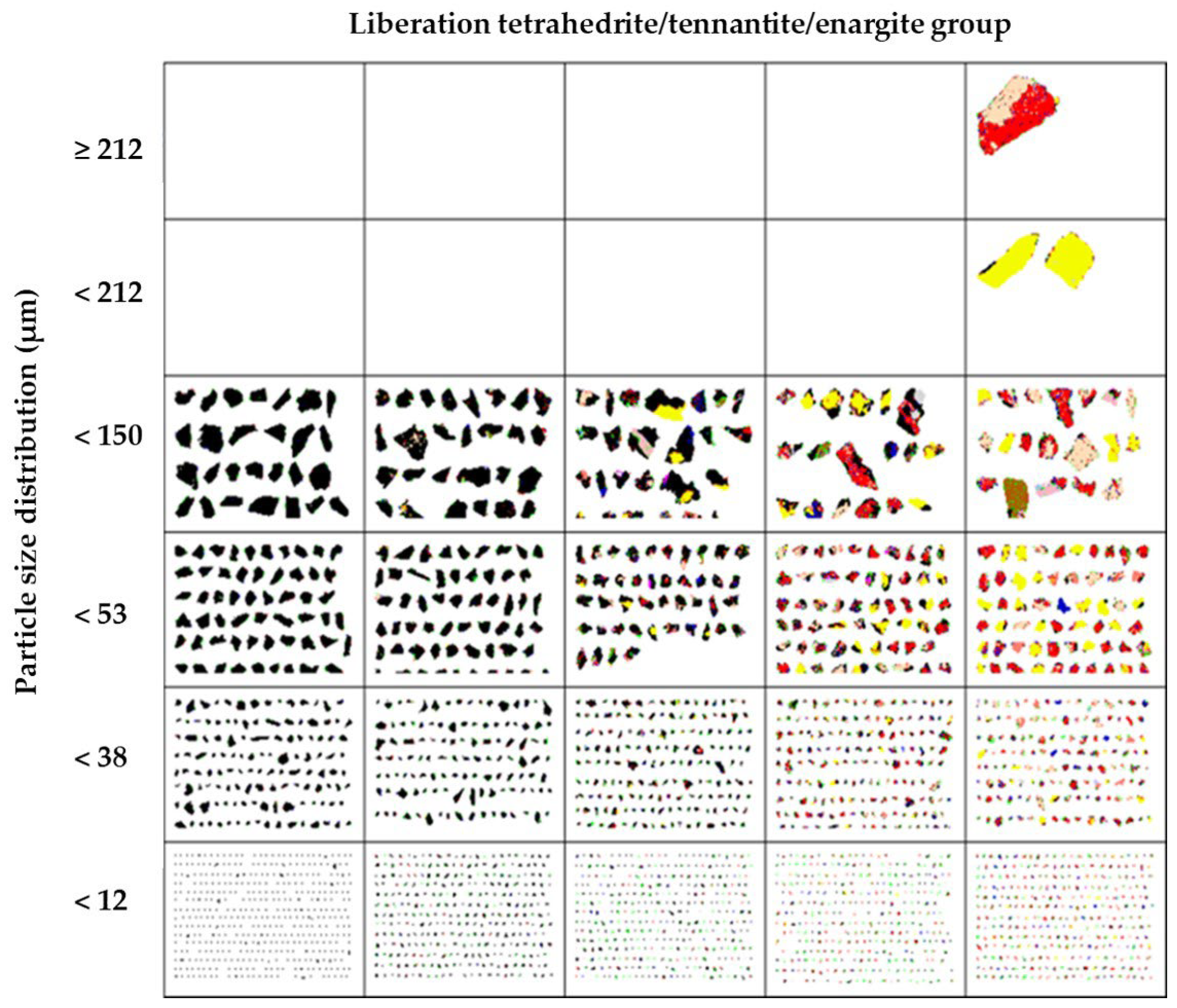

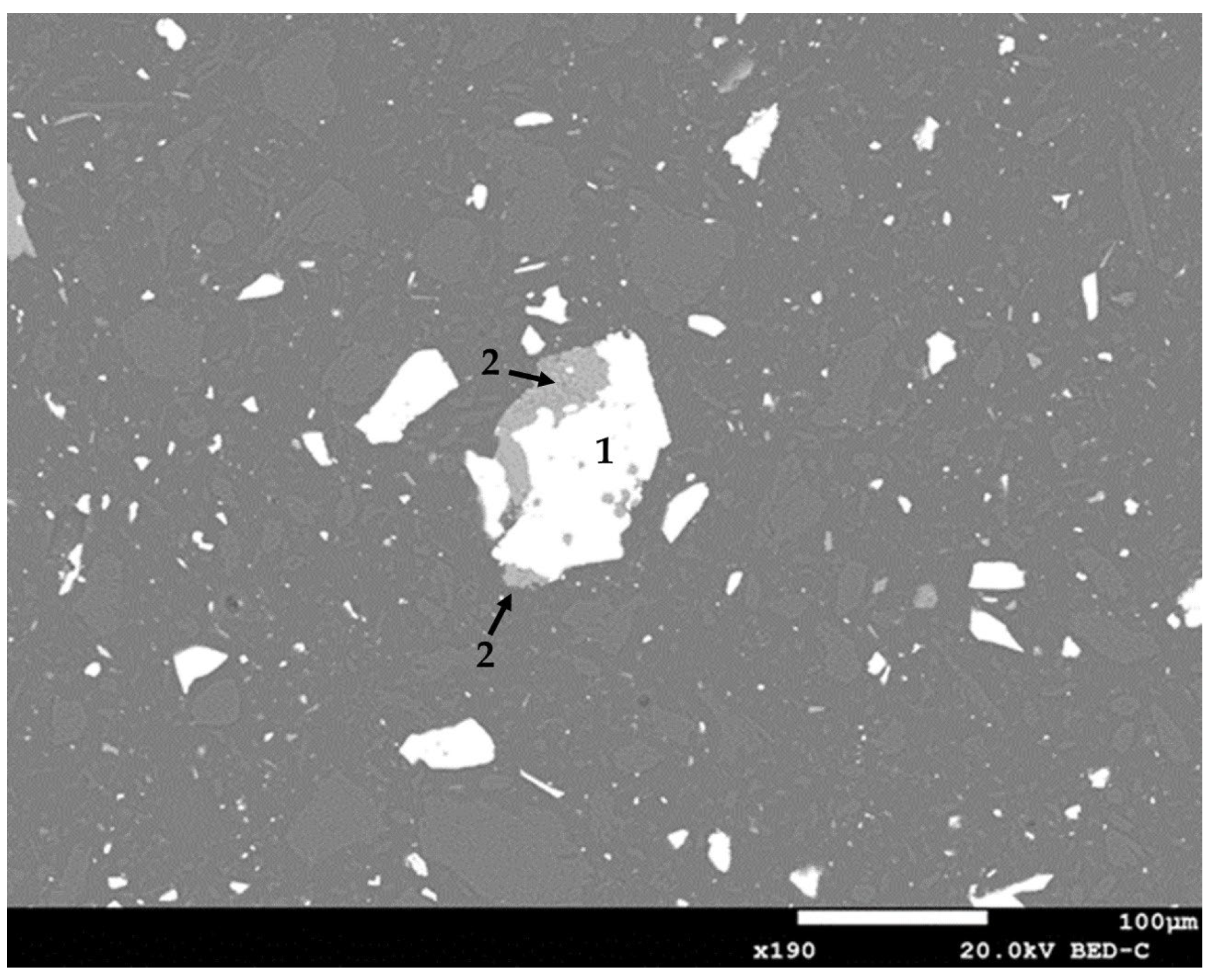
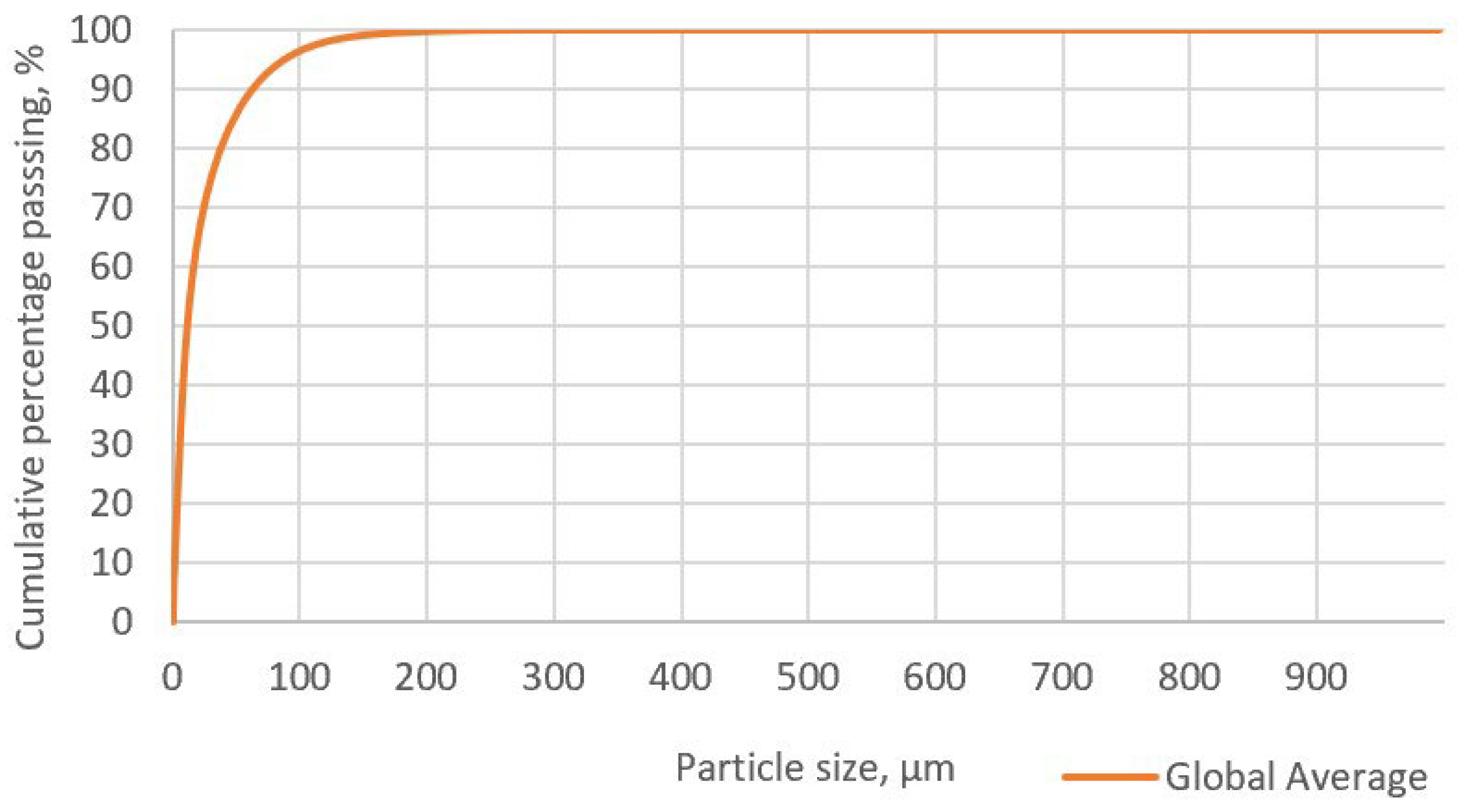
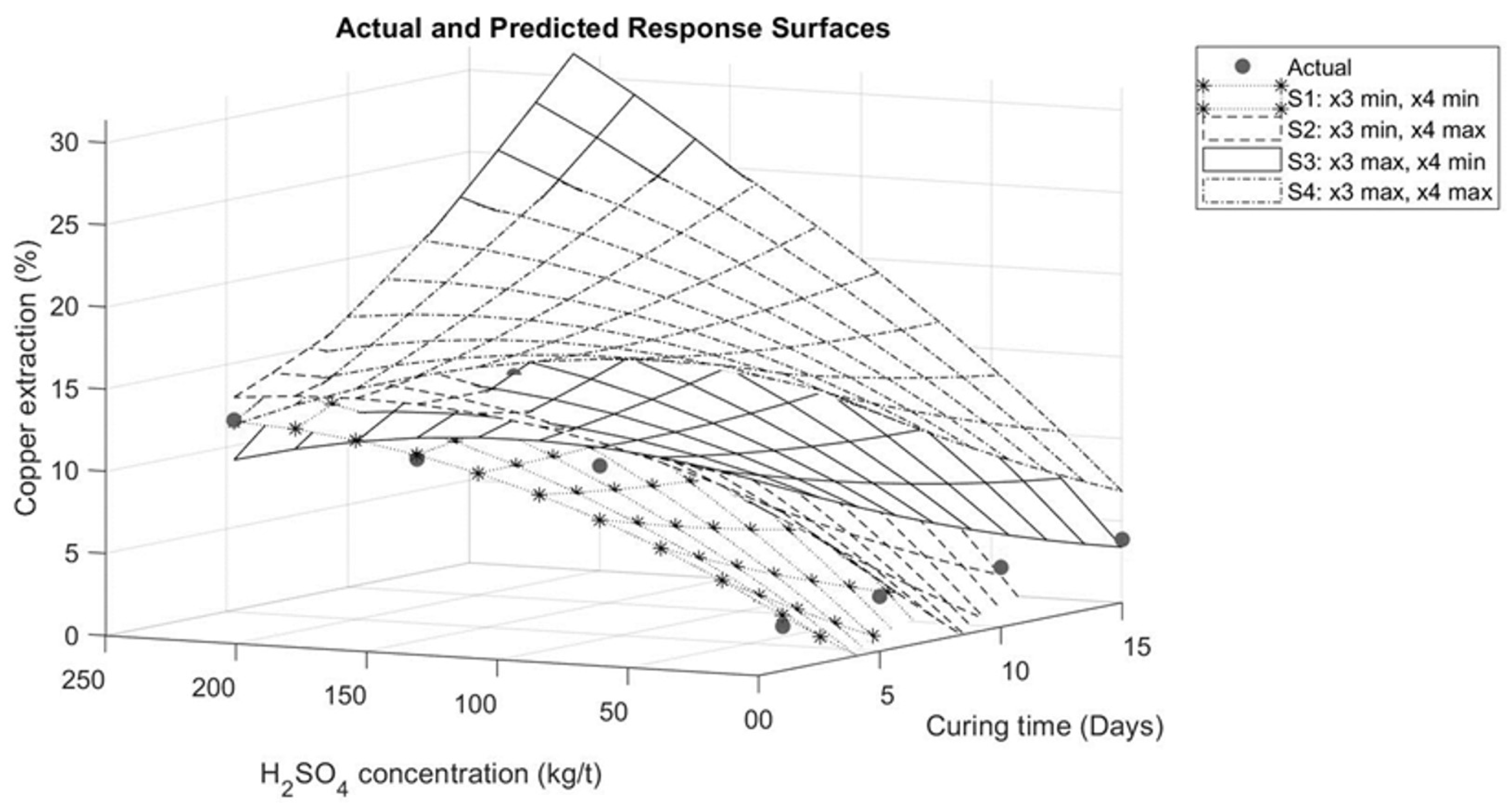
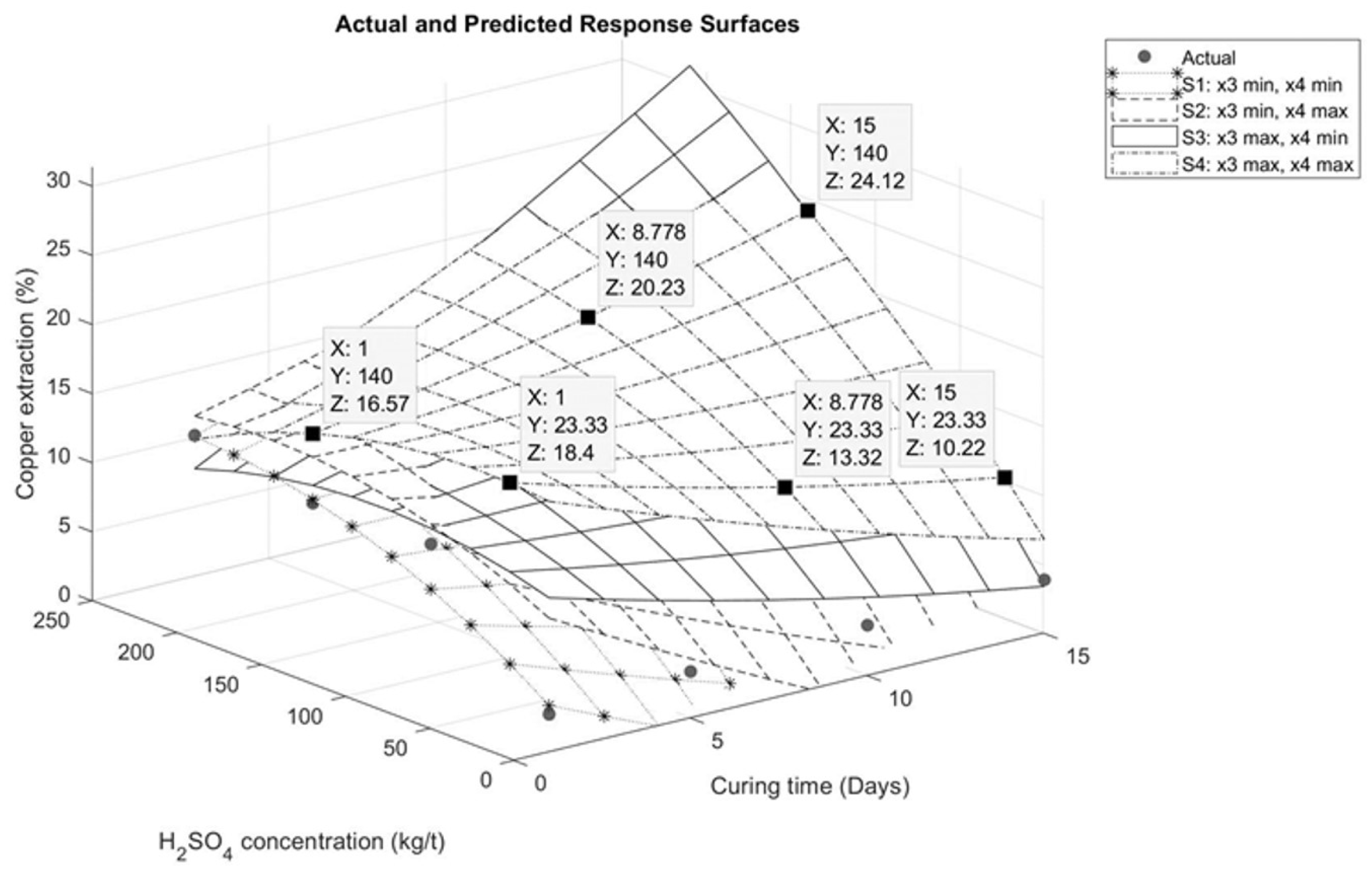


| Parameters | Levels | |||
|---|---|---|---|---|
| 1 | 2 | 3 | 4 | |
| Curing time (days) | 1 | 5 | 10 | 15 |
| H2SO4 (kg/t) | 0 | 70 | 140 | 210 |
| NaCl (kg/t) | 0 | 25 | 50 | 100 |
| Temperature (°C) | 25 | 35 | 50 | 75 |
| Curing Time | H2SO4 (kg/t) | NaCl (kg/t) | Temperature (°C) |
|---|---|---|---|
| 1 | 0 | 0 | 0 |
| 1 | 70 | 25 | 35 |
| 1 | 140 | 50 | 50 |
| 1 | 210 | 100 | 75 |
| 5 | 0 | 25 | 50 |
| 5 | 70 | 0 | 75 |
| 5 | 140 | 100 | 25 |
| 5 | 210 | 50 | 35 |
| 10 | 0 | 50 | 75 |
| 10 | 70 | 100 | 50 |
| 10 | 140 | 0 | 35 |
| 10 | 210 | 25 | 25 |
| 15 | 0 | 100 | 35 |
| 15 | 70 | 50 | 25 |
| 15 | 140 | 25 | 75 |
| 15 | 210 | 0 | 50 |
| Component | Content (%) |
|---|---|
| Total Cu | 35.57 |
| Soluble Cu | 1.580 |
| Total Fe | 12.98 |
| Total As | 5.910 |
| Mineral | % Mass |
|---|---|
| Chalcocite/digenite | 16.55 |
| Covellite | 3.980 |
| Chalcopyrite | 4.660 |
| Bornite | 6.010 |
| Tetrahedrite/tennantite/enargite | 35.93 |
| Other Cu minerals | 2.150 |
| Pyrite | 22.35 |
| Sphalerite | 2.270 |
| Iron oxides/hydroxides | 0.020 |
| Alunite | 0.320 |
| Quartz | 2.110 |
| Kaolinite group | 1.090 |
| White micas-muscovite | 1.170 |
| Smectite group (montmorillonite—nontreonite) | 0.050 |
| Pyrophyllite/andalusite | 0.220 |
| Others | 1.110 |
| Test | Curing Time (Days) | H2SO4 (kg/t) | NaCl (kg/t) | Temperature (°C) | % Cu Extraction |
|---|---|---|---|---|---|
| 1 | 1 | 0 | 0 | 25 | 2.730 |
| 2 | 1 | 70 | 25 | 35 | 11.81 |
| 3 | 1 | 140 | 50 | 50 | 11.53 |
| 4 | 1 | 210 | 100 | 75 | 13.21 |
| 5 | 5 | 0 | 25 | 50 | 3.370 |
| 6 | 5 | 70 | 0 | 75 | 10.69 |
| 7 | 5 | 140 | 100 | 25 | 15.41 |
| 8 | 5 | 210 | 50 | 35 | 16.59 |
| 9 | 10 | 0 | 50 | 75 | 3.660 |
| 10 | 10 | 70 | 100 | 50 | 14.90 |
| 11 | 10 | 140 | 0 | 35 | 14.45 |
| 12 | 10 | 210 | 25 | 2 | 21.51 |
| 13 | 15 | 0 | 100 | 35 | 3.880 |
| 14 | 15 | 70 | 50 | 25 | 9.030 |
| 15 | 15 | 140 | 25 | 75 | 17.71 |
| 16 | 15 | 210 | 0 | 50 | 26.71 |
Disclaimer/Publisher’s Note: The statements, opinions and data contained in all publications are solely those of the individual author(s) and contributor(s) and not of MDPI and/or the editor(s). MDPI and/or the editor(s) disclaim responsibility for any injury to people or property resulting from any ideas, methods, instructions or products referred to in the content. |
© 2024 by the authors. Licensee MDPI, Basel, Switzerland. This article is an open access article distributed under the terms and conditions of the Creative Commons Attribution (CC BY) license (https://creativecommons.org/licenses/by/4.0/).
Share and Cite
Quezada, V.; Villagrán, G.; Calisaya-Azpilcueta, D.; Marín, N. Effect of Pretreatment on a Copper Concentrate with High Arsenic Content. Minerals 2024, 14, 419. https://doi.org/10.3390/min14040419
Quezada V, Villagrán G, Calisaya-Azpilcueta D, Marín N. Effect of Pretreatment on a Copper Concentrate with High Arsenic Content. Minerals. 2024; 14(4):419. https://doi.org/10.3390/min14040419
Chicago/Turabian StyleQuezada, Víctor, Geraldine Villagrán, Daniel Calisaya-Azpilcueta, and Natalia Marín. 2024. "Effect of Pretreatment on a Copper Concentrate with High Arsenic Content" Minerals 14, no. 4: 419. https://doi.org/10.3390/min14040419
APA StyleQuezada, V., Villagrán, G., Calisaya-Azpilcueta, D., & Marín, N. (2024). Effect of Pretreatment on a Copper Concentrate with High Arsenic Content. Minerals, 14(4), 419. https://doi.org/10.3390/min14040419







